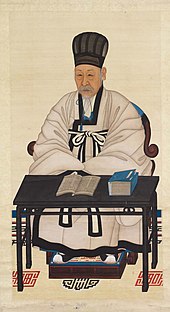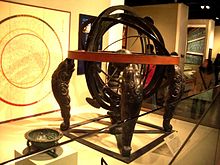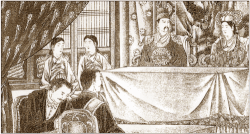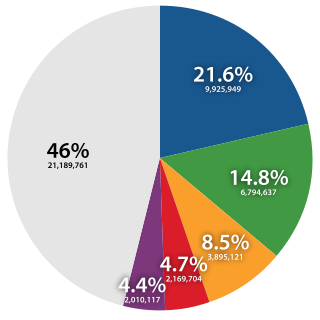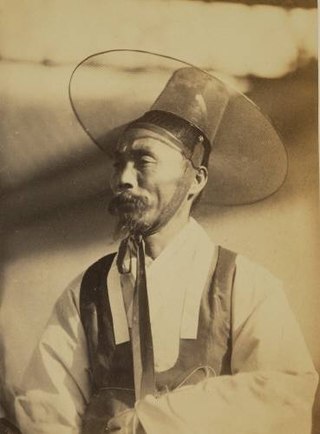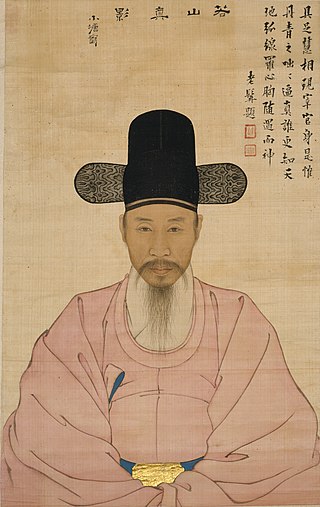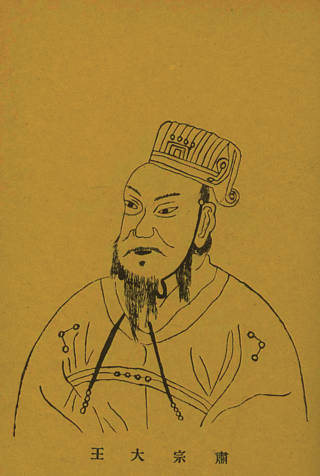Joseon 조선 고려국 (1392–1393) 高麗國 조선국 (1393–1894) 朝鮮國 대조선국 (1894–1897) 大朝鮮國 | |||||||||||
|---|---|---|---|---|---|---|---|---|---|---|---|
| 1392–1897 | |||||||||||
Royal Seal  | |||||||||||
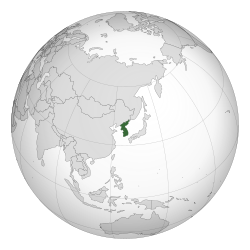 Territory of Joseon after King Sejong's conquest of Jurchens in 1433 (with current borders) | |||||||||||
| Status | Tributary relations with the Ming and Qing (1401–1895)a Qing intervention (1882–1894)a [1] [2] [3] [4] Japanese intervention (1894–1896) | ||||||||||
| Capital | Main: Hanseong (now Seoul) (1394–1399/1405–1897) Temporary: Gaegyeong (1392–1394/1399–1405) | ||||||||||
| Official languages | Middle Korean, Early Modern Korean, Classical Chinese [5] [6] : 243, 329 [7] : 74 (literary Chinese or Hanmun in Korean) | ||||||||||
| Religion | Confucianism (state ideology), Buddhism, Shamanism, Taoism, Christianity (recognized in 1886) | ||||||||||
| Demonym(s) | Korean | ||||||||||
| Government | Absolute monarchy [8] | ||||||||||
| King | |||||||||||
• 1392–1398 | Taejo (first) | ||||||||||
• 1864–1897 | Gojong (last) | ||||||||||
| Chief State Councillor [note 1] | |||||||||||
• 1392 | Bae Geuk-ryeom (first) | ||||||||||
• 1894–1898 | Kim Byeong-si (last) | ||||||||||
| Legislature | None (rule by decree) (until 1894) Jungchuwon (from 1894) | ||||||||||
| History | |||||||||||
• Coronation of Taejo | August 5 1392 | ||||||||||
• change the name of a country from Goryeo to Joseon | March 28, 1393 | ||||||||||
| October 9, 1446 | |||||||||||
| 1592–1598 | |||||||||||
| 1627, 1636–1637 | |||||||||||
| February 26, 1876 | |||||||||||
| April 17, 1895 | |||||||||||
| October 13 1897 | |||||||||||
| Population | |||||||||||
• 1519 [9] | 3,300,000 | ||||||||||
• 1648 [10] | 2,576,000 | ||||||||||
• 1717 [10] | 10,056,000 | ||||||||||
• 1777 [10] | 9,074,000 | ||||||||||
• 1807 [10] | 9,377,000 | ||||||||||
| Currency | Mun (1423–1425, 1625–1892) Yang (1892–1897) | ||||||||||
| |||||||||||
| Today part of | North Korea South Korea | ||||||||||
| |||||||||||
History
This section needs additional citations for verification .(May 2024) |
Early period (late 14th-mid 16th century)
| History of Korea |
|---|
 |
| Timeline |
| |
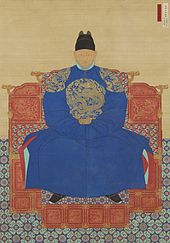
Founding
By the late 14th century, the nearly 500-year-old Goryeo established in 918 was tottering, its foundations collapsing from years of war spilled over from the disintegrating Yuan dynasty. Following the emergence of the Ming dynasty, the royal court in Goryeo split into two conflicting factions, one favouring neutrality and the other wanting to retake the Liaodong peninsula, which many in Goryeo believed was theirs. Goryeo remained a neutral third-party observer in the conflict between the Yuan and the Ming and had friendly diplomatic relations with both. [19] In 1388, a Ming messenger came to Goryeo to demand that territories of the former Ssangseong Prefectures be handed over to Ming China. The tract of land was taken by Mongol forces during the invasion of Korea, but had been reclaimed by Goryeo in 1356 as the Yuan dynasty weakened. The act caused an uproar among the Goryeo court, and General Ch'oe Yŏng seized the chance to argue for an invasion of the Ming-controlled Liaodong Peninsula.
General Yi Sŏng-gye was chosen to lead the attack; he revolted, swept back to the capital Gaegyeong (now Kaesong) and initiated a coup d'état, overthrowing King U of Goryeo in favor of his son, Chang of Goryeo (1388). Neo-Confucian scholars, who were a small and medium-sized power at the time, were able to use this incident as an opportunity to lay a political foundation, and in particular, Jeong Do-jeon, a friend of Yi Sŏng-gye, wanted to use this incident as an opportunity to reform the corrupt nobles and the Buddhist community. He later killed King U and his son after a failed restoration and forcibly placed a royal named Wang Yo on the throne (he became King Gongyang of Goryeo). In 1392, Yi eliminated Chŏng Mong-ju, a highly respected leader of a group loyal to Goryeo dynasty, and dethroned King Gongyang, exiling him to Wonju, and he ascended the throne himself. The Goryeo kingdom had come to an end after 474 years of rule.
In the beginning of his reign, Yi Sŏng-gye, now ruler of Korea, intended to continue to use the name Goryeo for the country he ruled and simply change the royal line of descent to his own, thus maintaining the façade of continuing the 500-year-old Goryeo tradition. After numerous threats of mutiny from the drastically weakened but still influential Gwonmun nobles, who continued to swear allegiance to the remnants of the Goryeo and to the now-demoted Wang clan, the consensus in the reformed court was that a new dynastic title was needed to signify the change. In naming the new kingdom, Taejo contemplated two possibilities – "Hwaryeong" (his place of birth) and "Joseon". After much internal deliberation, as well as endorsement by the neighboring Ming dynasty's emperor, Taejo declared the name of the kingdom to be Joseon, a tribute to the ancient Korean state of Gojoseon. [20] He also moved the capital to Hanseong (modern Seoul) from Gaegyeong (modern Kaesong).
Strifes of princes

When the new dynasty was brought into existence, Taejo brought up the issue of which son would be his successor. Although Yi Bang-won, Taejo's fifth son by Queen Sinui, had contributed the most to assisting his father's rise to power, Chief State Councillor Jeong Do-jeon and Nam Eun used their influence on the king to name Yi Bang-seok, his eighth son (second son of Queen Sindeok), as crown prince in 1392. This conflict arose largely because Jeong Do-jeon, who shaped and laid down ideological, institutional, and legal foundations of the new kingdom more than anyone else, saw Joseon as a kingdom led by ministers appointed by the king while Yi Bang-won wanted to establish an absolute monarchy ruled directly by the king. With Taejo's support, Jeong Do-jeon kept limiting the royal family's power by prohibiting political involvement of princes and attempting to abolish their private armies. Both sides were well aware of each other's great animosity and were getting ready to strike first.
After the sudden death of Queen Sindeok, while King Taejo was still in mourning for his second wife, Yi Bang-won struck first by raiding the palace and killed Jeong Do-jeon and his supporters as well as Queen Sindeok's two sons (his half-brothers) including the crown prince in 1398. This incident became known as the "First Strife of Princes".
Aghast at the fact that his sons were willing to kill each other for the crown, and psychologically exhausted from the death of his second wife, King Taejo abdicated and immediately crowned his second son Yi Bang-gwa as King Jeongjong. One of King Jeongjong's first acts as monarch was to revert the capital to Gaegyeong, where he is believed to have been considerably more comfortable, away from the toxic power strife. Yet Yi Bang-won retained real power and was soon in conflict with his disgruntled older brother, Yi Bang-gan, who also yearned for power. In 1400, the tensions between Yi Bang-won's faction and Yi Bang-gan's camp escalated into an all-out conflict that came to be known as the "Second Strife of Princes". In the aftermath of the struggle, the defeated Yi Bang-gan was exiled to Dosan while his supporters were executed. Thoroughly intimidated, King Jeongjong immediately invested Yi Bang-won as heir presumptive and voluntarily abdicated. That same year, Yi Bang-won assumed the throne of Joseon as King Taejong, third king of the dynasty.
Consolidation of royal power
In the beginning of Taejong's reign, the former King Taejo refused to relinquish the royal seal that signified the legitimacy of any king's rule. Regardless, Taejong initiated policies he believed would prove his qualification to rule. One of his first acts as king was to abolish the privilege enjoyed by the upper echelons of government and the aristocracy to maintain private armies. His revocation of such rights to field independent forces effectively severed their ability to muster large-scale revolts, and drastically increased the number of men employed in the national military. Taejong's next act as king was to revise the existing legislation concerning the taxation of land ownership and the recording of state of subjects. With the discovery of previously hidden land, national income increased twofold.
In 1399, Taejong had played an influential role in scrapping the Dopyeong Assembly, a council of the old government administration that held a monopoly in court power during the waning years of Goryeo, in favor of the State Council of Joseon, a new branch of central administration that revolved around the king and his edicts. After passing the subject documentation and taxation legislation, he issued a new decree in which all decisions passed by the State Council could only come into effect with the approval of the king. This ended the custom of court ministers and advisors making decisions through debate and negotiations amongst themselves, and thus brought the royal power to new heights.
Shortly thereafter, Taejong installed an office, known as the Sinmun Office, to hear cases in which aggrieved subjects felt that they had been exploited or treated unjustly by government officials or aristocrats. He kept Jeong Do-jeon's reforms intact for the most part. In addition, Taejong executed or exiled many of his supporters who had helped him ascend the throne to strengthen his own royal authority. To limit the influence of in-laws, he killed all four of his wife's brothers and Shim On, the father-in-law of his son Sejong.
Taejong remains a controversial figure who killed many of his rivals and relatives to gain power and yet ruled effectively to improve the populace's lives, strengthen national defense, and lay down a solid foundation for his successor Sejong's rule.
Sejong the Great


In August 1418, following Taejong's abdication two months earlier, Sejong the Great ascended the throne. In May 1419, King Sejong, under the advice and guidance of his father Taejong, embarked upon the Gihae Eastern Expedition to remove the nuisance of waegu (coastal pirates) who had been operating out of Tsushima Island.
In September 1419, the daimyō of Tsushima, Sadamori, capitulated to the Joseon court. In 1443, The Treaty of Gyehae was signed in which the daimyō of Tsushima was granted rights to conduct trade with Korea using fifty ships per year in exchange for sending tribute to Korea and aiding to stop any Waegu coastal pirate raids on Korean ports. [21] [22] [23] [24]
On the northern border, Sejong established four forts and six posts to safeguard his people from the Jurchens, who later became the Manchus, living in Manchuria. In 1433, Sejong sent Kim Jong-seo, a government official, north to fend off the Jurchens. Kim's military campaign captured several castles, pushed north, and expanded Korean territory, roughly the current border between North Korea and China. [25]
During the rule of Sejong, Korea saw advances in natural science, agriculture, literature, traditional Chinese medicine, and engineering. Because of such success, Sejong was given the title "Sejong the Great". [26] The most remembered contribution of King Sejong is the creation of Hangul, the Korean alphabet, in 1443. Rejected in its time by the scholarly elite, the everyday use of Hanja in writing was eventually surpassed by Hangul in the latter half of the 20th century.
Six martyred ministers
After King Sejong's death, his son Munjong continued his father's legacy but soon died of illness in 1452, just two years after his coronation. He was succeeded by his twelve-year-old son, Danjong. In addition to two regents, Princess Gyeonghye also served as Danjong's guardian and, along with the general Kim Jong-seo, attempted to strengthen royal authority. [27] Danjong's uncle, Grand Prince Suyang, gained control of the government and eventually deposed his nephew to become the seventh king of Joseon himself in 1455, taking the name Sejo. After six ministers loyal to Danjong attempted to assassinate Sejo to return Danjong to the throne, Sejo executed the six ministers and also killed Danjong in his place of exile.
King Sejo enabled the government to determine exact population numbers and to mobilize troops effectively. He also revised the land ordinance to improve the national economy and encouraged the publication of books. Most importantly, he compiled the Grand Code for State Administration, which became the cornerstone of dynastic administration and provided the first form of constitutional law in a written form in Korea.
Sejo undermined much of the foundation of many existing systems, including the Jiphyeonjeon which his predecessors, Sejong and Munjong, had carefully laid down. He cut down on everything he deemed unworthy and caused countless complications in the long run. Many of these adjustments were done for his own power, not regarding the consequences and problems that would occur. The favoritism he showed toward the ministers who aided him in taking the throne led to increased corruption in the higher echelon of the political field.
Institutional arrangements and Prosper culture
Sejo's weak son Yejong succeeded him as the eighth king, but died two years later in 1469. Yejong's nephew Seongjong ascended the throne. His reign was marked by the prosperity and growth of the national economy and the rise of neo-Confucian scholars called sarim who were encouraged by Seongjong to enter court politics. He established Hongmungwan, the royal library and advisory council composed of Confucian scholars, with whom he discussed philosophy and government policies. He ushered in a cultural golden age that rivaled Sejong's reign by publishing numerous books on geography, ethics, and various other fields.
He also sent several military campaigns against the Jurchens on the northern border in 1491, like many of his predecessors. The campaign, led by General Heo Jong, was successful, and the defeated Jurchens, led by the Udige clan (兀狄哈), retreated to the north of the Yalu River. King Seongjong was succeeded by his son, Yeonsangun, in 1494.
Literati purges

Yeonsangun is often considered the worst tyrant in Joseon's history, whose reign was marked by literati purges between 1498 and 1506. His behavior became erratic after he learned that his biological mother was not Queen Junghyeon but the deposed Queen Yun, who was forced to drink poison after poisoning one of Seongjong's concubines out of jealousy and leaving a scratch mark on Seongjong's face. When he was shown a piece of clothing that was allegedly stained with his mother's blood vomited after drinking poison, he beat two of Seongjong's concubines, who had accused Queen Yun to death, and pushed his grandmother, Grand Queen Dowager Insu, who died afterward. He executed government officials who supported Queen Yun's death along with their families. He also executed sarim scholars for writing phrases critical of Sejo's usurpation of the throne.
Yeonsangun also seized a thousand women from the provinces to serve as palace entertainers and appropriated the Sungkyunkwan as a personal pleasure ground. He abolished the Office of Censors, whose function was to criticize inappropriate actions and policies of the king, and Hongmungwan. He banned the use of hangul when the common people used it on posters to criticize the king. After twelve years of misrule, he was finally deposed in a coup which placed his half-brother Jungjong on the throne in 1506.
Jungjong was a fundamentally weak king because of the circumstances that placed him on the throne, but his reign also saw a period of significant reforms led by his minister Jo Gwang-jo, the charismatic leader of sarim. He established a local self-government system called hyangyak to strengthen local autonomy and communal spirit among the people, sought to reduce the gap between the rich and poor with a land reform that would distribute land to farmers more equally and limit the amount of land and number of slaves that one could own, promulgated Confucian writings with vernacular translations widely among the populace, and sought to trim the size of government by reducing the number of bureaucrats. According to the Veritable Records of the Joseon Dynasty , it was said that no official dared to receive a bribe or exploit the populace during this time because as Inspector General, he applied the law strictly.
These radical reforms were very popular with the populace but were fiercely opposed by the conservative officials who had helped to put Jungjong on the throne. They plotted to cause Jungjong to doubt Jo's loyalty. Jo Gwang-jo was executed, and most of his reform measures died with him in the resulting third literati purge. For nearly 50 years afterward, the court politics were marred by bloody and chaotic struggles between factions backing rival consorts and princes. In-laws of the royal family wielded great power and contributed to much corruption in that era.
Middle period (mid 16th-mid 17th century)

The middle Joseon period was marked by intense and bloody power struggles between political factions that weakened the country, and by large-scale invasions by Japan and Manchu which nearly toppled the kingdom.
Factional struggle
The Sarim faction had suffered a series of political defeats during the reigns of Yeonsangun, Jungjong, and Myeongjong, but it gained control of the government during the reign of King Seonjo. It soon split into opposing factions known as the Easterners and the Westerners by their political or philosophical masters. Easterners mainly followed the teachings and philosophy of Yi Hwang and Jo Sik while the Westerners followed the philosophy of Yi I and Song Hon. [28] [29] Within decades the Easterners themselves divided into the Southerners and the Northerners; in the seventeenth century the Westerners also permanently split into the Noron and the Soron. [30] Factions in the Joseon dynasty were formed based on their different interpretations of Confucian philosophy, which mainly differed according to who their master was and what they believed in. [31] The alternations in power among these factions were often accompanied by charges of treason and bloody purges, initiating a cycle of revenge with each change of regime.
One example is the 1589 rebellion of Jeong Yeo-rip, one of the bloodiest political purges of Joseon. Jeong Yeo-rip, an Easterner, had formed a society with a group of supporters that also received military training to fight against Waegu. There is still a dispute about the nature and purpose of his group, which reflected the desire for a classless society and spread throughout Honam. He was subsequently accused of conspiracy to start a rebellion. Jeong Cheol, head of the Western faction, was in charge of investigating the case and used this event to affect the widespread purge of Easterners who had the slightest connection to Jeong Yeo-rip. Eventually 1000 Easterners were killed or exiled in the aftermath.
Japanese invasions

Throughout Korean history, there was frequent piracy on sea and brigandage on land. The only purpose for the Joseon navy was to secure the maritime trade against the Waegu. The navy repelled pirates using an advanced form of gunpowder technologies including cannons and fire arrows in form of singijeon deployed by hwacha.
During the Japanese invasions in the 1590s, Toyotomi Hideyoshi, plotting the conquest of Ming China with Portuguese guns, invaded Korea with his daimyōs and their troops, intending to use Korea as a stepping stone. Factional division in the Joseon court, inability to assess Japanese military capability, and failed attempts at diplomacy led to poor preparation on Joseon's part. The use of superior firearms by the Japanese left most of the southern part of the Korean Peninsula occupied within months, with both Hanseong (present-day Seoul) and Pyongyang captured.

The invasion was slowed when Admiral Yi Sun-shin destroyed the Japanese invasion fleet. The guerrilla resistance that eventually formed also helped. Local resistance slowed down the Japanese advance and decisive naval victories by Admiral Yi left control over sea routes in Korean hands, severely hampering Japanese supply lines. Furthermore, Ming China intervened on the side of the Koreans, sending a large force in 1593 which pushed back the Japanese together with the Koreans.
During the war, Koreans developed powerful firearms and the turtle ships. The Joseon and Ming forces defeated the Japanese at a deep price. Following the war, relations between Korea and Japan were completely suspended until 1609.
Manchu invasions

After the Japanese invasions, the Korean Peninsula was devastated. Meanwhile, Nurhaci (r. 1583–1626), the chieftain of the Jianzhou Jurchens, was unifying the Jurchen tribes of Manchuria into a strong coalition that his son Hong Taiji (r. 1626–1643) would eventually rename the "Manchus". After he declared Seven Grievances against Ming China in 1618, Nurhaci and the Ming engaged in several military conflicts. On such occasions, Nurhaci required help from Gwanghaegun of Joseon (r. 1608–1623), putting the Korean state in a difficult position because the Ming court was also requesting assistance. [32] Gwanghaegun tried to maintain neutrality, but most of his officials opposed him for not supporting Ming China, which had saved Joseon during Hideyoshi's invasions. [32]
In 1623, Gwanghaegun was deposed and replaced by Injo of Joseon (r. 1623–1649), who banished Gwanghaegun's supporters. Reverting his predecessor's foreign policy, the new king decided to openly support the Ming, but a rebellion led by military commander Yi Gwal erupted in 1624 and wrecked Joseon's military defenses in the north. [32] Even after the rebellion had been suppressed, King Injo had to devote military forces to ensure the stability of the capital, leaving fewer soldiers to defend the northern borders. [32]
In 1627, a Jurchen army of 30,000 led by Nurhaci's nephew Amin overran Joseon's defenses. [33] After a quick campaign that was assisted by northern yangban who had supported Gwanghaegun, the Jurchens imposed a treaty that forced Joseon to accept "brotherly relations" with the Jurchen kingdom. [34] Because Injo persisted in his anti-Manchu policies, Qing emperor Hong Taiji sent a punitive expedition of 120,000 men to Joseon in 1636. [35] Defeated, King Injo was forced to end his relations with the Ming and recognize the Qing as suzerain instead. [36] Injo's successor Hyojong of Joseon (r. 1649–1659) tried to form an army to keep his enemies away and conquer the Qing for revenge, but could never act on his designs. [37]
Despite reestablishing economic relations by officially entering the imperial Chinese tributary system, Joseon leaders and intellectuals remained resentful of the Manchus, whom they regarded as barbarians, and [34] regarded the Ming dynasty as the center of the civilized world. [38] Joseon intellectuals, who had political and cultural allegiances to the Ming dynasty, [39] were forced to reexamine their state identity when the Qing overthrew the Ming, [38] leading to an influx of Ming refugees into Joseon. [39] As a result, Joseon created the Little China ideology, known as sojunghwa. [38] According to Youngmin Kim, " it held that the Joseon embodied Chineseness authentically while other neighboring countries failed to do so in the face of the barbarian domination of the center of the civilized world." [38] A set of standardized rites and unifying symbols were developed in Late Joseon Korea to maintain that sense of cultural identity. [38] Long after submitting to the Qing, the Joseon court and many Korean intellectuals kept using Ming reign periods, as when a scholar marked 1861 as "the 234th year of Chongzhen". [40]
Late period (mid 17th-late 19th century)
Emergence of Silhak and renaissance of the Joseon


After invasions from Japan and Manchuria, Joseon experienced a nearly 200-year period of peace. Joseon witnessed the emergence of Silhak (Practical Learning). The early group of Silhak scholars advocated comprehensive reform of civil service examination, taxation, natural sciences and the improvement in agromanagerial and agricultural techniques. It aimed to rebuild Joseon society after it had been devastated by the two invasions. Under the leadership of Kim Yuk, the chief minister of King Hyeonjong, the implementation of reforms proved highly advantageous both to state revenues and to the lot of the peasants.
The co-existence system between Southerners and Westerners which were established after the Injo coup started to fall. [41] After the Yesong debate, factional conflict grew particularly intense under the reigns of the kings Sukjong and Gyeongjong, with major rapid reversals of the ruling faction, known as hwanguk (換局; literally change in the state of affairs), being commonplace. During the early reign of Sukjong, the southerners managed to become a ruling faction and made westerners lose power. But the southerners' rise to power was temporary. Sukjong, who believed that political faction would weaken the king's power started rapid reversals of the ruling faction, which resulted in bloody killings between factions. After the three bloody hwanguk, the Southerners lost their influence in the central government, and the ruling Westerners were divided into hard-line Noron who rejected the Southerners and moderate Soron who were friendly to the Southerners. This shift resulted in political radicalism which viewed other factions as the ones that should be eliminated. [41] [42] In response, the next kings, Yeongjo (r. 1724–1776) and Jeongjo (r. 1776–1800), generally pursued the Tangpyeongchaek – a policy of maintaining balance and equality between the factions. [43] [44]
The two kings led a second renaissance of the Joseon kingdom. [45] [46] Yeongjo's grandson, the enlightened King Jeongjo enacted various reforms throughout his reign, notably establishing Kyujanggak, a royal library to improve the cultural and political position of Joseon and to recruit gifted officers to run the nation. King Jeongjo also spearheaded bold social initiatives, opening government positions to those who would previously have been barred because of their social status. King Jeongjo had the support of the many Silhak scholars. King Jeongjo's reign also saw the further growth and development of Joseon's popular culture. At that time, the group of Silhak scholars encouraged the individual to reflect on state traditions and lifestyle, initiating the studies of Korea that addressed its history, geography, epigraphy and language.

Architecture
During the late Joseon period of the 18th and 19th centuries, Joseon started to change its perceptions of the Qing dynasty. [47] The shift in perceptions commenced through the introduction of Qing dynasty culture to Joseon society by Yeonhaengsa, Korean envoys to the Qing dynasty. [47] Progressive-thinking Joseon intellectuals advocated the Bukhak theory, which argued that Joseon should adopt Qing and Western culture through the Qing dynasty. [47] Joseon scholars became intrigued by the sophisticated architectural technology of China, encompassing construction techniques, wagon utilization, and the ondol heating system. [47] Particularly fascinated by brick, the proponents of Bukhak endeavored to popularize its usage across Joseon, and eventually succeeded. [47] Bak Jiwon was among the first to construct brick Chinese-style buildings in Anui, Gyeongsang Province, and Gyedong, Seoul, towards the end of the 18th century. [47] Following the establishment of the Suwon Hwaseong Fortress, which was influenced by Qing construction technology and techniques, Qing-style architectural style and techniques started to become more widespread in Joseon society. [47]
Government by in-law families
After the death of King Jeongjo, the Joseon faced difficult external and internal problems. Internally, the foundation of national law and order weakened as a result of "Sedo Politics" (in-law government) by royal in-laws.
The young Sunjo succeeded his father, King Jeongjo, in 1800. With Jeongjo's death the Noron seized power with the regency of Queen Dowager Jeongsun, whose family had strong ties to the faction, and initiated a persecution of Catholics. However, after the retirement and death of the Queen Dowager, the Norons were gradually ousted, while the Andong Kim clan of Kim Jo-sun, the father of the Queen Sunwon, gained power. Gradually the Andong Kims came to dominate the court. [48]
With the domination of the Andong Kims, the era of Sedo Politics began. The formidable in-law lineage monopolized the vital positions in government, holding sway over the political scene, and intervening in the succession of the throne. These kings had no monarchic authority and could not rule over the government. The other aristocratic families, overwhelmed by the power exercised by the royal in-laws, could not speak out. As the power was concentrated in the hands of the royal in-law lineage, there was disorder in the governing process, and corruption became rampant. Large sums were offered in bribes to the powerful lineages to obtain positions with nominally high rank. Even the low-ranking posts were bought and sold. This period, which spanned 60 years, saw the manifestation of both severe poverty among the Korean population and ceaseless rebellions in various parts of the country.
Externally, Joseon became increasingly isolationist. Its rulers sought to limit contact with foreign countries.
End of the dynasty
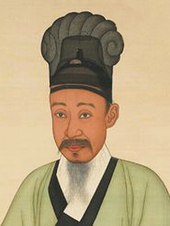
In 1863, King Gojong took the throne. His father, Heungseon Daewongun, ruled for him until Gojong reached adulthood. During the mid-1860s the Regent was the main proponent of isolationism and the instrument of the persecution of native and foreign Catholics, a policy that led directly to the French Campaign against Korea in 1866. The early years of his rule also witnessed a large effort to restore the dilapidated Gyeongbokgung, the seat of royal authority. From 1862 to 1864, an insurgency movement driven by Donghak followers and religious leader Choe Je-u gathered a peasant army to take over southern parts of Korea until Choe was executed in 1864. [49]
During his reign, the power and authority of the in-law families such as the Andong Kims sharply declined. To get rid of the Andong Kim and Pungyang Jo clans, he promoted persons without making references to political party or family affiliations, and to reduce the burdens of the people and solidify the basis of the nation's economy, he reformed the tax system. In 1871, U.S. and Korean forces clashed in a U.S. attempt at "gunboat diplomacy" following on the General Sherman incident of 1866.

In 1873, King Gojong announced his assumption of royal rule. With the subsequent retirement of Heungseon Daewongun, Queen Min (later called Empress Myeongseong) became a power in the court, placing her family in high court positions.
Japan, after the Meiji Restoration, acquired Western military technology, and forced Joseon to sign the Treaty of Ganghwa in 1876, opening three ports to trade and granting the Japanese extraterritoriality. Port Hamilton was briefly occupied by the Royal Navy in 1885. [50]

Many Koreans despised Japanese and foreign influences over their land and the corrupt oppressive rule of the Joseon dynasty. In 1881, the Byeolgigun, a modern elite military unit, was formed with Japanese trainers. The salaries of the other soldiers were held back, and in 1882 rioting soldiers attacked the Japanese officers and even forced the queen to take refuge in the countryside. In 1894, the Donghak Peasant Revolution saw farmers rise up in a mass rebellion, with peasant leader Jeon Bong-jun defeating the forces of local ruler Jo Byong-gap at the battle of Gobu on January 11, 1894; after the battle, Jo's properties were handed out to the peasants. By May, the peasant army had reached Jeonju, and the Joseon government asked the Qing dynasty government for assistance in ending the revolt. The Qing sent 3,000 troops, and the rebels negotiated a truce, but the Japanese considered the Qing presence a threat and sent in 8,000 troops of their own, seizing the Royal Palace in Seoul and installing a pro-Japanese government on June 8, 1894. This soon escalated into a war (1894–1895) between Japan and the Qing Empire, fought largely in Korea. (The king made a deal with Japan, partially out of a distrust of the queen's support for open trade policies toward the Western civilizations and China. He ended up preempting a specific disadvantageous, exclusive negotiation with Japan previous to the Queen's decision, which was later used as a political premise for Japan to wage military action. Scholars, particularly during the Joseon era, were touted for expressing allegiance to the king.)
Empress Myeongseong (referred to as Queen Min) [51] had attempted to counter Japanese interference in Korea and was considering turning to the Russian Empire and to China for support. In 1895, Empress Myeongseong was assassinated by Japanese agents. [52] The Japanese minister to Korea, Lieutenant-General Viscount Miura, almost certainly orchestrated the plot against her. A group of Japanese agents [52] entered the palace Gyeongbokgung in Seoul, which was under Japanese control, [52] and Queen Min was killed and her body desecrated in the north wing of the palace.
The Qing acknowledged defeat in the Treaty of Shimonoseki (April 17, 1895), which officially guaranteed Korea's independence from China. [53] It was a step toward Japan gaining regional hegemony in Korea.
Establishment of the Empire and Colonization
The Joseon court, pressured by encroachment from larger powers, felt the need to reinforce national integrity and declared the Korean Empire, along with the Gwangmu Reform in 1897. King Gojong assumed the title of Emperor to assert Korea's independence. In addition, other foreign powers were sought for military technology, especially Russia, to fend off the Japanese. Technically, 1897 marks the end of the Joseon period, as the official name of the empire was changed; the Joseon dynasty still reigned, albeit perturbed by Japan and Russia.
In a complicated series of maneuvers and counter-maneuvers, Japan pushed back the Russian fleet at the Battle of Port Arthur in 1904. With the conclusion of the 1904–1905 Russo-Japanese War with the Treaty of Portsmouth, the way was open for Japan to take control of Korea. After the signing of the Protectorate Treaty in 1905, Korea became a protectorate of Japan. Prince Itō was the first Resident-General of Korea, although he was assassinated by Korean independence activist An Jung-geun in 1909 at the train station at Harbin. In 1910 the Japanese Empire finally annexed Korea.










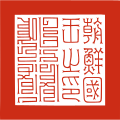





![Portrait of the Inspector General Yun Bonggu [ko] (1681-1767) yunbonggu cosang.jpg](http://upload.wikimedia.org/wikipedia/commons/thumb/2/24/%EC%9C%A4%EB%B4%89%EA%B5%AC_%EC%B4%88%EC%83%81.jpg/170px-%EC%9C%A4%EB%B4%89%EA%B5%AC_%EC%B4%88%EC%83%81.jpg)


